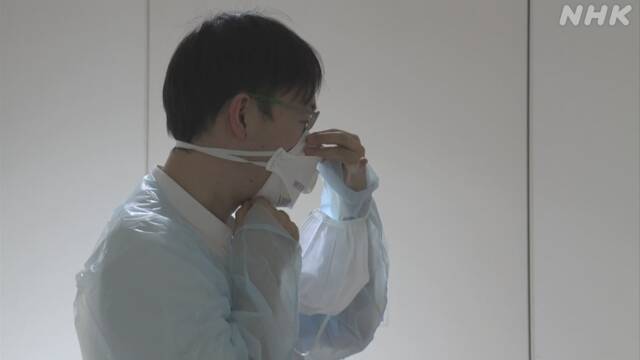Due to the re-expansion of the infection, which is said to be the fourth wave of the new coronavirus, the dedicated beds are almost full even at hospitals in central Tokyo.
There are many younger generation patients who develop severe pneumonia even if they do not have an underlying disease, and doctors are raising a sense of crisis.
Saiseikai Central Hospital in Minato-ku, Tokyo is accepting patients with about 20 corona beds, and from the end of last month to this month, it is almost full.
There was a day when six people were requested to be hospitalized, and at that time only half were accepted.
In the third wave, most of the patients were elderly, but in the spread of infection, which is said to be the fourth wave, the proportion of younger generations and working generations who are hospitalized increases, causing severe pneumonia even without underlying disease. It means that you can see it.
The hospital does not test for mutant viruses, but doctors believe they may be mutant viruses.
According to doctors, until now, about 10 days after starting treatment, there were many cases where the patient was expected to be discharged from the hospital, but recently, after 10 days, the patient has a fever again and the symptoms worsen. Although the cause is unknown, there are complications such as bleeding from the stomach, and it is necessary to carefully examine not only the treatment of corona but also changes in the general condition.
Dr. Ayumu Yoshito, an infectious disease specialist at Saiseikai Central Hospital in Tokyo, said, "The characteristic of the 4th wave is that the symptoms of pneumonia are becoming more severe in young people, working people, and people without underlying diseases. The situation continues, and we have no choice but to decline the request for hospitalization. "
The "fourth wave" felt by the treating doctor is ...
Dr. Ayumu Yoshito, an infectious disease specialist who treats new corona patients at Saiseikai Central Hospital in Tokyo, said that the spread of infection, which is said to be the fourth wave, is due to inpatients in the younger generation and the working generation than in the third wave. It is said that it is increasing.
A week before the beds began to tighten, 19 people were hospitalized in the two corona wards in the hospital, with 2 in their 20s, 1 in their 30s, 3 in their 40s, and 50s. There are 6 people, 1 person in their 60s, 2 people in their 70s, 1 person in their 80s, and 3 people in their 90s.
The number of inpatients in the younger and working generations is increasing.
Symptomatology worsens quickly, and there are cases in which even the working generation needs to consider whether to use a respirator.
In addition, about 10 days after starting treatment, there were many cases where it was expected that the patient would be discharged from the hospital, but recently, after 10 days, the fever has recurred and the symptoms have worsened. There are also complications such as bleeding from the stomach and symptoms of cell destruction, which means that it is necessary to carefully examine not only the treatment of corona but also changes in the general condition.
Dr. Yoshito said, "It is necessary to comprehensively treat not only the new corona but also such complications, and a higher degree of specialization is required. Depending on the treatment, labor and manpower may be more than ever. In some cases, it is necessary. "
"Now is on the brink so that medical care does not become tight"
The number of young and working generation corona patients is increasing, and the Tokyo Saiseikai Central Hospital will accept two new patients in their 50s even when we were interviewing in the hospital on the 12th. I did.
One of them had no serious underlying illness, but upon examination, the oxygen status in his blood was poor and he was being considered for a ventilator.
In addition, a patient in his 40s who was hospitalized had no underlying illness, but when he was hospitalized because he had a high fever, he was found to have already had severe pneumonia.
It was a case in which the symptoms worsened to the point where oxygen inhalation was required on the same day, and it was necessary to consider whether to attach a respirator.
On the other hand, it is said that there are cases in which even if the symptoms worsen temporarily, they can be recovered.
The patient in his 60s was able to continue living at home, despite his malaise, but suddenly lost consciousness and was transported by ambulance.
Already, the oxygen status in the blood was getting worse, so a ventilator was immediately put on at this hospital.
However, with the subsequent treatment, the symptoms improved and he had recovered to the point where he could move to a rehabilitation facility soon.
From experience so far, he has argued that the treatment method for corona has been decided, and even severely ill patients may recover, and medical care should not be strained in order to save lives that can be saved.
Dr. Ayumu Yoshito, an infectious disease specialist at Saiseikai Central Hospital in Tokyo, said, "One of the causes of medical strain is that people who have been waiting at home or undergoing medical treatment at a hotel have to be hospitalized. Patients who had difficulty saving their lives a year ago can now be helped by stable treatment. Treating them will improve their lives. To save lives, prevent medical care from becoming tight. It is necessary, and now is the brink. "

